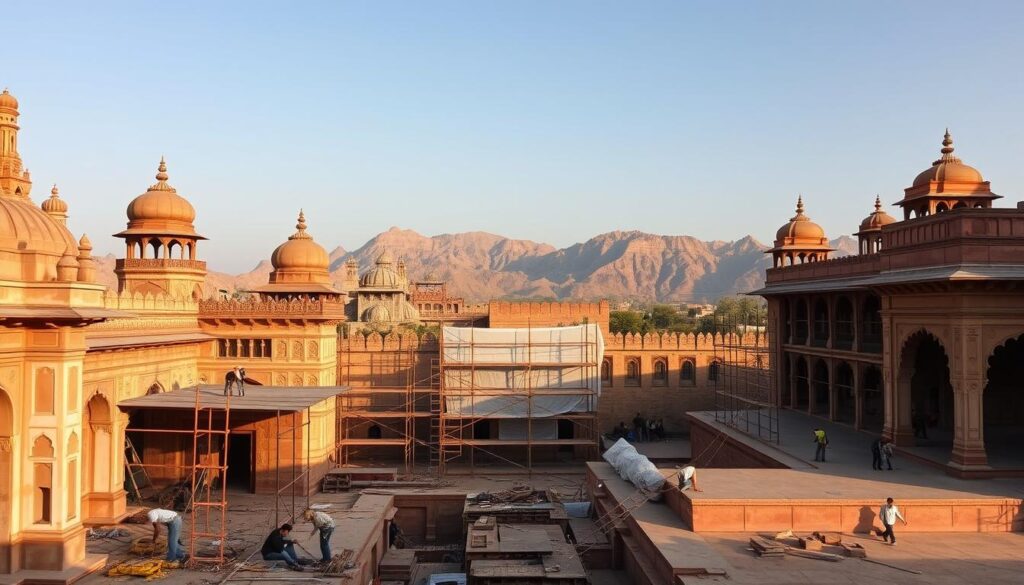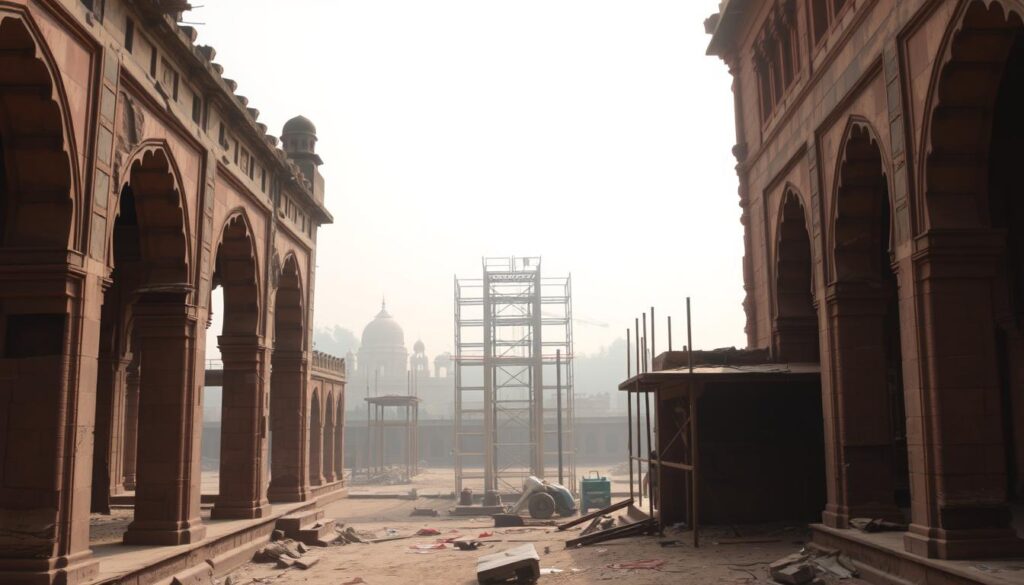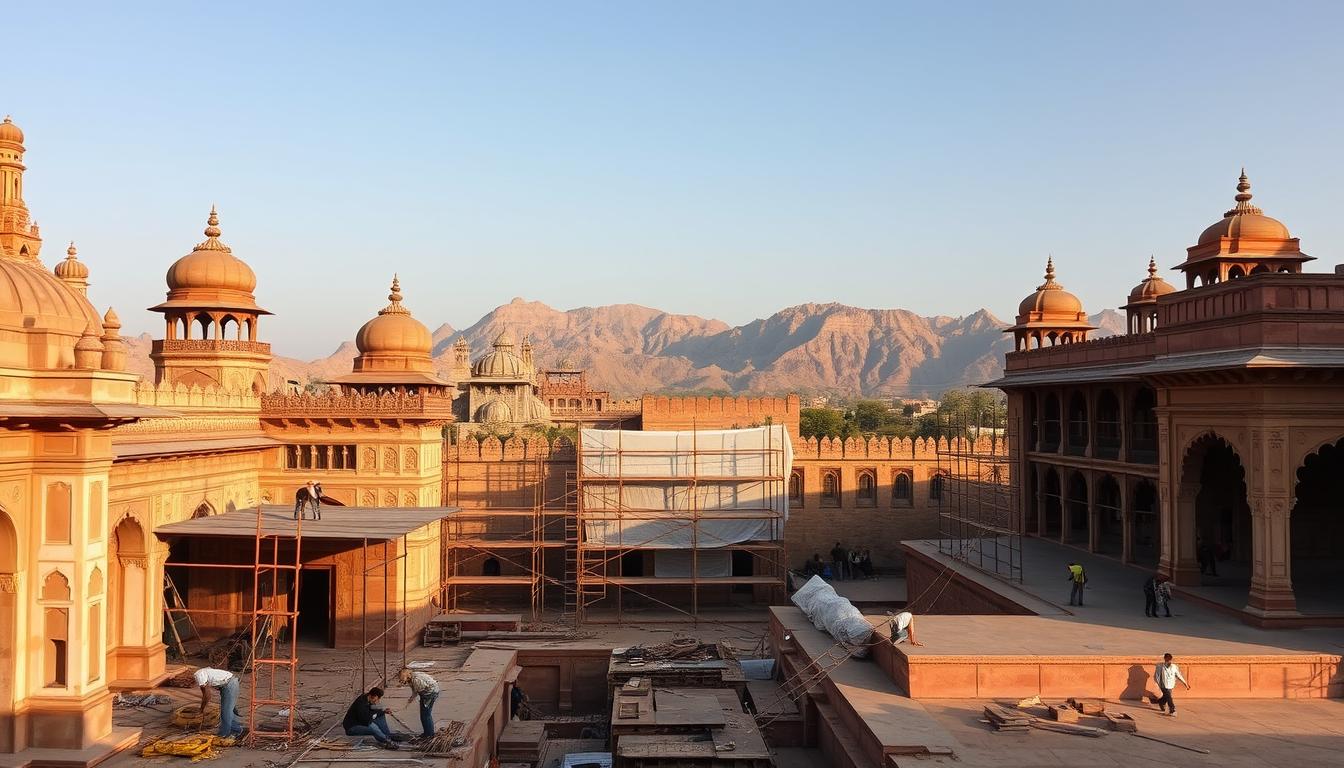What were the challenges faced during the restoration of Fatehpur Sikri: Uncover the fascinating story behind the restoration of the magnificent Fatehpur Sikri in India.
Fatehpur Sikri is a UNESCO World Heritage Site. It shows India’s rich cultural heritage. Built by Mughal Emperor Akbar in the 16th century, it has seen many challenges. These include environmental damage and structural problems.

Restoring Fatehpur Sikri is a big job. It needs to tackle many challenges while keeping its history intact. We’re working hard to fix structures and keep the site’s historical value. We’ll look at the problems the team faced and how they solved them.
Key Takeaways
- Fatehpur Sikri faces significant environmental and structural challenges.
- The restoration process involves preserving historical integrity.
- Innovative solutions are being implemented to overcome restoration challenges.
- The site’s cultural heritage is being maintained through careful restoration.
- Restoration efforts are complex and multifaceted.
The Historical Significance of Fatehpur Sikri
Fatehpur Sikri shows the greatness of the Mughal Empire under Akbar. We look at its architecture and history. It was built in 1569 by Akbar and was the Mughal capital for 14 years.
Related Posts: How did Fatehpur Sikri’s architecture influence later Mughal buildings?
The Architectural Marvel of Emperor Akbar’s Capital
Fatehpur Sikri is a stunning example of Mughal architecture. It mixes Indian, Persian, and Islamic styles. The Buland Darwaza and Panch Mahal show Akbar’s dream of blending cultures. The architectural marvels of Fatehpur Sikri continue to inspire wonder and awe.

The Abandonment and Centuries of Neglect
Fatehpur Sikri was left empty because of water problems. It has been ignored for many years. This neglect has harmed its buildings.
Preserving Fatehpur Sikri is key. It’s not just a historical site but a cultural gem. Restoration efforts aim to fix the damage from years of neglect and environmental harm.
What were the challenges faced during the restoration of Fatehpur Sikri?
The restoration of Fatehpur Sikri, a UNESCO World Heritage Site, was a complex task. We faced many challenges that threatened our efforts. These difficulties made the project very hard to complete.
Environmental Degradation and Climate Impact
Environmental degradation was a big challenge. The red sandstone used in Fatehpur Sikri is easily damaged by weather. Climate change made things worse, causing more damage. We had to find ways to protect the site from these environmental factors.

Structural Instability and Red Sandstone Deterioration
Structural instability was another major challenge. The old structures needed to be stabilized to prevent collapse. The red sandstone also needed to be conserved to stop its deterioration. We used new techniques to keep the site stable and the sandstone preserved.
Documentation Gaps and Historical Accuracy Issues
There was a lack of detailed documentation and historical records. This made it hard to ensure the restoration work was accurate and authentic. We had to use historical research and archaeological evidence to guide our work. This way, we could stay true to the original construction.
By tackling these challenges, we found effective solutions to restore Fatehpur Sikri. Our work not only saved a significant cultural site but also deepened our understanding of the Mughal era’s history and architecture.
Innovative Solutions in the Restoration Process
New ideas and teamwork from around the world have helped restore Fatehpur Sikri. This project mixes old ways of doing things with new conservation methods. This mix helps keep this historical site safe.
Blending Traditional Craftsmanship with Modern Conservation
The restoration work has combined old skills with new technology. Local artists have used traditional methods to fix detailed carvings and buildings. At the same time, modern tools have made these repairs last longer.
This mix keeps Fatehpur Sikri true to its past while making it stronger against nature’s effects.
International Collaboration and Technical Expertise
Experts from all over the world have helped restore Fatehpur Sikri. They’ve brought new ideas and knowledge. This teamwork has made the restoration better and shown a global commitment to saving cultural treasures.
This effort has led to using the best ways to conserve Fatehpur Sikri. This ensures it will be here for people to see in the future.
Conclusion
The restoration of Fatehpur Sikri is an ongoing effort. It needs constant work to keep it safe for the future. We face many challenges, like environmental damage and building problems.
Thanks to new ideas and teamwork, we’ve made big steps in fixing this amazing place. We mix old skills with new methods to solve some of these problems.
We must keep working to save places like Fatehpur Sikri. It’s crucial to protect these sites for their history, culture, and beauty. Let’s make sure they are safe for everyone to enjoy.
FAQ
What were the main challenges faced during the restoration of Fatehpur Sikri?
Restoring Fatehpur Sikri was tough. It faced environmental damage, structural issues, and missing records. The red sandstone used in its construction weathers easily, causing damage.
How has climate change impacted the restoration of Fatehpur Sikri?
Climate change made things worse for Fatehpur Sikri. Extreme weather damaged the structures more. Rising temperatures and changing rain patterns sped up the sandstone’s decay.
What innovative solutions have been employed in the restoration of Fatehpur Sikri?
Restoring Fatehpur Sikri mixed old skills with new methods. Local craftsmen used traditional ways to fix the carvings and buildings.
How has international collaboration contributed to the restoration of Fatehpur Sikri?
International help was key in restoring Fatehpur Sikri. Experts from everywhere shared their knowledge. This ensured top-quality work with the latest tools and materials.
What measures have been taken to ensure the historical accuracy and authenticity of the restoration work?
The team used historical records to keep the restoration true to the original. Despite missing documents, they aimed to match the site’s original look and design.
What are the ongoing challenges in preserving historical sites like Fatehpur Sikri?
Keeping sites like Fatehpur Sikri safe is an ongoing battle. It faces environmental harm, structural problems, and the need for constant care. Protecting these places for the future needs a lasting commitment.

My name is Radha Sharma and I live in Agra. I have started this first blog of my life Agrafast.in to make my future in blogging by watching videos of many big bloggers through the internet for a long time.

